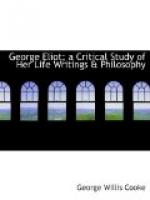That the main purpose of Daniel Deronda is not that of defending Judaism, must be apparent to every attentive reader. The Jewish race is made use of for purposes of illustration, as a notable example in proof of her theories. There is a deeper purpose conspicuous throughout the hook, which rests on her conceptions of the spiritual life as a development of tradition. This larger purpose also jests on her altruistic conception of the moral and spiritual life. As Professor Kaufmann has pointed out, the story falls into two widely separated portions, in one of which the Jewish element appears, in the other the English. Jewish life and its religious spirit are contrasted with English life and a common type of its religion. This is not a contrast, however, which is introduced for the purpose of disparaging Christianity or English social life, but with the object of comparing those whose life is anchored in the spiritual traditions of a great people, with those who find the centre of their life in egotism and an individualistic spirit. Grandcourt is a type of pure egotism; Gwendolen is a creature who lives for self and with no law outside of her own happiness. This is the spirit of the society in which they both move. On the other hand, Mordecai lives in his race, Deronda gives his life constantly away for others, and Mirah is unselfishness and simplicity itself. So distinctly is this contrast drawn, so clearly are these two phases of life brought over against each other, that the book seems to be divided in the middle, and to be two separate works joined by a slender thread. This artistic arrangement has been severely criticised, but its higher purpose is only understood when this comparison and antagonism is recognized. Then the true artistic arrangement vindicates itself, and the unity of the book becomes apparent. Deronda moves in both these worlds, and their influence on him is finely conceived. He finds no spiritual aim and motive for his life until he is led into the charmed circle of a traditional environment, and learns to live in and for his race. Living for self, the life of Gwendolen is blasted, her hopes crushed, and she finds no peace or promise




